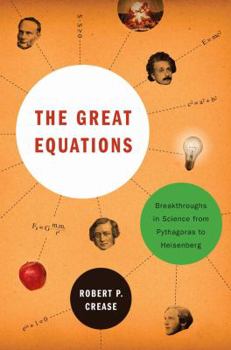The Great Equations: Breakthroughs in Science from Pythagoras to Heisenberg
Select Format
Select Condition 
Book Overview
Philosopher and science historian Robert P. Crease tells the stories behind ten of the greatest equations in human history. Was Nobel laureate Richard Feynman really joking when he called Maxwell's electromagnetic equations the most significant event of the nineteenth century? How did Newton's law of gravitation influence young revolutionaries? Why has Euler's formula been called "God's equation," and why did a mysterious ecoterrorist make it his...
Format:Hardcover
Language:English
ISBN:039306204X
ISBN13:9780393062045
Release Date:January 2009
Publisher:W. W. Norton & Company
Length:224 Pages
Weight:1.13 lbs.
Dimensions:1.1" x 5.9" x 8.5"
Age Range:14 to 17 years
Grade Range:Grades 9 to 12
Customer Reviews
5 ratings
A Great Equation Book
Published by Thriftbooks.com User , 14 years ago
An excellent book on the history of physics and math. Inside of trying to be exhaustive, the author takes a clever approach: choose world-changing equations,then work backwards from them to discuss the personalities of the discoverers and the intellectual background that led to the discoveries. The one-line equations often took years of work to produce; in the most amusing case, Heisenberg unwittingly re-invented matrix mathematics because he hadn't learnt it in school. Toward the end the author gets vague because quantum theory requires a huge abmount of introduction, but other popular-science books have had the same problem, and I won't deduct stars for it. There are entertaining digressions: a section on how Aristotle's worldview differs from the modern one, and a discussion of why Orwell's 1984 keeps harping on "2 + 2 = 4". An entertaining and informative read.
The Great Equations
Published by Thriftbooks.com User , 14 years ago
The books was described as "new" and was exactly that. I'm very pleased. Thanks.
The top ten ideas of all time
Published by Thriftbooks.com User , 14 years ago
The Great Equations summarizes what the author feels are the ten greatest equations in the history of human intelligence, and who could argue with him? During the time reading it, I thought about Planck's resolution of the Blackbody Radiation Paradox, Dirac's QED eq, leading to anti-matter (actually Dirac was trying to unify Quantum Mechanics with Special Relativity, but 'stumbled' onto anti-matter),or Hubble's expanding universe, but guess top 13 would be unlucky. Listed, not by import, but chronologically as follows: 1-Phythagoras's Theorem (~700 BC), which states that the sum of the squares of the lengths of the two sides whose vertex is a right angle, equals the square of the third side. This is not just some schoolchild postulate, but is the basis of ancient civilization. Structures and ideas were constructed on the basis of this deep insightful concept. But there is proof that in Asia, and South America, a similar theorem was proposed, evidenced by the level of their intellectual progress. 2-Newton's Second Law of Motion (1666), which states that any force produced by, or imposed upon a body, results from the product of its mass and its change in motion. This is the pillar upon which all explainations of motion and forces on any bodies, stand to this very day. Galileo was on the brink of this idea, but the concept of 'change in motion' was still too abstract then, plus he was having serious troubles with the Catholic Church. Sir Isaac was the first the understand this concept, and led him to discover differential calculus as an afterthought. 3-Newton's Universal Gravitation Law (1666). The main word here is Universal, implying that it is valid, not only on in merry ole England, or even the Earth, but anywhere in the heavenly skies. Remembering that we are not far removed from the medieval period, and to demonstrate this degree of dogmatic farsightness was nothing short of revolutionary. 4-Euler's Equation (1740's).(not Euler's eq for fluid dynamics, which is just a fluid version for #2) Here Euler combines the five most fundamental numbers in all of mathematics (base of the natural log, pi, square root of -1, one, and zero) into one simple arithmetic statement. I remember asking my math teacher if this was a coincidence, and he replied 'there are no coincidences in mathematics.', meaning that there is a deep interrelationship between the values of these numbers. 5-The Second Law of Thermodynamics (1840's - 1850's). Aka the Law of Entropy, it was the culmination of the work of many,and in the author's words, worthy of a 'Shakespearean drama'. This was the period of the Industrial Revolution, and the Steam engine was all the rage. It was left to the physicist to explain what is heat, and its effects on the environment. The plot and cast is as follows: Carnot examines heat engines; Joule and Kelvin quantify heat; Clasius introduces entropy; Boltzmann and Maxwell applies statistics to describe entropy, the first time probabalistic concep
Well received gift book
Published by Thriftbooks.com User , 14 years ago
Husband asked for this book for Christmas, he is a computer person but he enjoys reading this kind of thing. he enjoys it so much, he tries to explain some of it to me, and occasionally I even understand it a bit! I think that it must be written so intelligent people with an interest in the area can understand it. He has read things by Stephen Hawkings (A Brief History of Time) and a book called the Dancing Wu Li Masters, both of which are about physics, so this gives you some idea of the type of person who would appreciate it. I did look at the other reviews and can only say that these reviewers seem to know a lot about the areas covered in the book! Clearly the book covers more than physics!
Great service!
Published by Thriftbooks.com User , 15 years ago
All went smoothly. Got my book at a good price and delivered quickly and packged securely.






